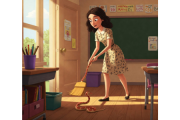Our family physician had his office in the San Bernardino district nearby. His son Jorge and daughter Mariela went to school with us. On the wall of his waiting room was a painting that both repelled and attracted me. I was by then quite familiar with the Latin American attitude to death, and its place in Roman Catholic worship. We were not Catholic, but our parents had long instilled in us a respect for the religious beliefs of others. Death’s existence was never denied here, as it is in much of the post-Christian English-speaking world, for every roadside shrine invariably marked a traffic fatality, a grim memento mori to remind passers-by of the need for caution, and numerous crucifixes outside churches and in public places reminded one of Christ’s supreme sacrifice on the Cross. A cross was seldom left empty, or ‘untenanted,’ as it is in most Protestant cultures. The realistic painting in our doctor’s waiting room unashamedly and prominently displayed his professional mission. It showed a young girl looking fearfully at a smiling skeleton who was holding one of her hands. Her other hand was being held by a medical doctor in a lab coat, grimly determined not to let her go. I did not find the painting morbid. On the contrary, this acceptance of the seriousness of the fight against illness and disease struck me as necessary, and the acceptance of death as the natural end to all life was itself life-affirming, far better, I came to realize, than the contemporary denial of the natural course of human events. I often wonder what effect this unvarnished truth would have on a nervous patient today. I will never forget the day I saw a funeral cortege making its slow procession down a shady Caracas avenue. An elderly man walking ahead of us stopped, took off his hat, bowed his head, crossed himself, and then after the black cars passed, went on his way. There was no reason to think he had any connection with the deceased, but every reason for him and everyone else to recall that, as the poet John Donne reminds us, “Ask not for whom the bell tolls, / It tolls for thee.” We must all die. No one is exempt. This story reminds me of the black humour newsboys employed at the Plaza Altamira traffic lights. When they sold out of the daily paper El Mundo, they would call out “Se acabo El Mundo!” (‘It’s the end of The World’). It also reminds me of the famous Realist painting in the National Gallery by the Venezuelan artist Cristobal Rojas (1858-1890), La primera y ultima comunion, of a young girl in white, close to death from TB, with her grieving mother, held in a chair and bathed by an unearthly translucent light, being administered her first (and last) Communion by the attending priest. I was awestruck and humbled then, and remain so today, more than sixty years later, by the image of this tragic loss of a young girl snatched prematurely from her family, being prepared for her meeting with God.
At about this time, my father had somehow or other been persuaded to invest in “True Blue” offshore real estate in Grenada, then a British colony. Perhaps my parents longed for some property of their own in what seemed to be a secure and law-abiding place to which they could eventually retire not far from the Venezuelan coast. While they listened to the financial implications of their purchase, I spent hours studying the impressive diorama of the planned island community in the office, with its miniature houses, Matchbox cars driving on the left, docks and jetties, shops and services, all surrounded by the ‘true blue’ sea. Arrangements were made for us to go and see it in person. Before we could leave, however, a better house in Altamira than Lufy had become available, so the trip was postponed. We had first to visit Quinta Chabela, soon to be our last Caracas home.

The current eight-star flag of Venezuela was introduced in 2006. (link)




